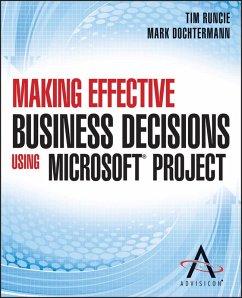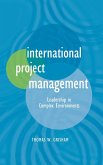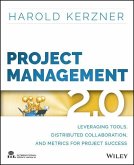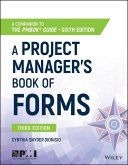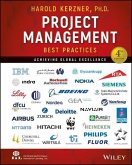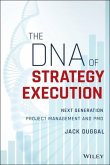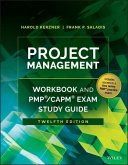- Broschiertes Buch
- Merkliste
- Auf die Merkliste
- Bewerten Bewerten
- Teilen
- Produkt teilen
- Produkterinnerung
- Produkterinnerung
This book and Web site package introduces students to human factors concepts and reinforces them using cases, articles, and examples on the Web site. The contents are organized around the flow of information in control-theoretic diagrams that link the various system elements, including the human element, to guide the analysis of real-world situations. The associated Web site enables customization for each course and professor so that content can be both uploaded and redesigned for specific classes.
Andere Kunden interessierten sich auch für
![International Project Management International Project Management]() Thomas W GrishamInternational Project Management117,99 €
Thomas W GrishamInternational Project Management117,99 €![Project Management 2.0 Project Management 2.0]() Harold KerznerProject Management 2.086,99 €
Harold KerznerProject Management 2.086,99 €![A Project Manager's Book of Forms A Project Manager's Book of Forms]() Cynthia Snyder DionisioA Project Manager's Book of Forms98,99 €
Cynthia Snyder DionisioA Project Manager's Book of Forms98,99 €![Project Management Best Practices: Achieving Global Excellence Project Management Best Practices: Achieving Global Excellence]() Harold KerznerProject Management Best Practices: Achieving Global Excellence115,99 €
Harold KerznerProject Management Best Practices: Achieving Global Excellence115,99 €![The DNA of Strategy Execution The DNA of Strategy Execution]() Jack DuggalThe DNA of Strategy Execution59,99 €
Jack DuggalThe DNA of Strategy Execution59,99 €![Service Systems Management and Engineering Service Systems Management and Engineering]() Ching M. ChangService Systems Management and Engineering171,99 €
Ching M. ChangService Systems Management and Engineering171,99 €![Project Management Workbook and Pmp / Capm Exam Study Guide Project Management Workbook and Pmp / Capm Exam Study Guide]() Harold KerznerProject Management Workbook and Pmp / Capm Exam Study Guide102,99 €
Harold KerznerProject Management Workbook and Pmp / Capm Exam Study Guide102,99 €-
-
-
This book and Web site package introduces students to human factors concepts and reinforces them using cases, articles, and examples on the Web site. The contents are organized around the flow of information in control-theoretic diagrams that link the various system elements, including the human element, to guide the analysis of real-world situations. The associated Web site enables customization for each course and professor so that content can be both uploaded and redesigned for specific classes.
Hinweis: Dieser Artikel kann nur an eine deutsche Lieferadresse ausgeliefert werden.
Hinweis: Dieser Artikel kann nur an eine deutsche Lieferadresse ausgeliefert werden.
Produktdetails
- Produktdetails
- Verlag: Wiley & Sons
- 1. Auflage
- Seitenzahl: 384
- Erscheinungstermin: 9. Januar 2013
- Englisch
- Abmessung: 231mm x 188mm x 25mm
- Gewicht: 612g
- ISBN-13: 9781118097397
- ISBN-10: 1118097394
- Artikelnr.: 34550817
- Herstellerkennzeichnung
- Libri GmbH
- Europaallee 1
- 36244 Bad Hersfeld
- gpsr@libri.de
- Verlag: Wiley & Sons
- 1. Auflage
- Seitenzahl: 384
- Erscheinungstermin: 9. Januar 2013
- Englisch
- Abmessung: 231mm x 188mm x 25mm
- Gewicht: 612g
- ISBN-13: 9781118097397
- ISBN-10: 1118097394
- Artikelnr.: 34550817
- Herstellerkennzeichnung
- Libri GmbH
- Europaallee 1
- 36244 Bad Hersfeld
- gpsr@libri.de
Tim Runcie is an industry-recognized technology and methodology expert. His twenty-plus year career has helped organizations leverage technologies (including Project, Project Server, and SharePoint) to achieve better ROI and cultural maturity in project, program, and portfolio management. Mark 'Doc' Dochtermann has spent more than thirty years working in almost every major corporation: from IBM, Oracle, Microsoft, Xerox, and in organizations that are focused on project and portfolio management. ADVISICON is a consulting firm that delivers strategic project control solutions using advanced project and portfolio management methodologies, custom application development, and consultative training. Their clients throughout North America and Latin America have realized quantifiable results through a unique approach of combining knowledge transfer, optimization and sustainability of processes, and technology while increasing stakeholder competencies. Advisicon's team of professionals includes PMI-certified Project Management Professionals® (PMPs), Microsoft Certified Professionals®, and Microsoft MVPs.
1 Business Intelligence: Knowledge of Key Success Ingredients for Project
Server 2010 1
In This Chapter 1
Maximizing PPM Ingredients, Culture, and Technology for Business Success 2
What Is the Project Management Lifecycle? 7
Information: What Fuels a PMO's Success? 16
Stakeholders in a Project Management Environment 21
Technology Meets Strategy: Welcome to the Business User Network 29
Important Concepts Covered in This Chapter 32
References 33
2 Value Proposition by Role of Project Server 2010 35
In This Chapter 35
Clairvoyance with Project/Server 2010: Forecast Future Results 37
Important Concepts Covered in This Chapter 75
References 77
3 Meeting CFO Needs with Project/Server 2010 79
In This Chapter 79
How the CFO Gets the Attention of the PMO 79
What and Why Is Work Management Critical to Organizational Success? 87
Synchronization of Strategic Objectives to Actual Effort 93
Important Concepts Covered in This Chapter 97
Reference 98
4 The Business Shakes Hands with the Microsoft Project 2010 Platform 99
In This Chapter 99
Logical Architecture Is More Natural for Business Users 100
Microsoft Project 2010 Platform Is Highly Extensible 122
Important Concepts Covered in This Chapter 130
References 131
5 End Users' Critical Success Factors: Using MS Project 2010 133
In This Chapter 133
Project Management in Small Business and the Enterprise 134
Initiating and Managing Projects Using the Microsoft Project Desktop Client
143
Being an Effective Enterprise Project Manager Using Microsoft Project
Server 161
Fluent Project Management Using the Fluent UI: Introducing the Ribbon 171
Important Concepts Covered in This Chapter 181
References 182
6 Thinking Local, Going Social: Project Teams Can Thrive Using Microsoft
Project Server 2010 185
In This Chapter 185
Project Management Looking Ahead 185
PPM Lifecycle 188
Important Concepts Covered in This Chapter 202
7 Better Together: Microsoft Project 2010 Worksites Using SharePoint Server
2010 203
In This Chapter 203
Integration of Collaboration, Social Media, and Project-Related Information
203
SharePoint Server 2010 Offers Critical Business Capabilities 208
Being Social in a Project Environment 217
Important Concepts Covered in This Chapter 221
8 Effective Transition of Strategy and Execution: Program Management Using
Microsoft Project Server 2010 223
In This Chapter 223
Projects Are the 'How,' Programs Are the 'Why' 224
Important Concepts Covered in This Chapter 249
References 249
9 Intelligent Business Planning and Controlling Using Microsoft Project
2010 251
In This Chapter 251
Understanding Strategic Planning with Project Server 251
Creating and Managing Portfolio Lifecycle for Project Server 256
Understanding and Building Business Drivers 259
Using Project Server to Master Demand Management 268
Building Project Selection Criteria 286
What the Effi cient Frontier Is and How to Use It 292
Working with Constraints in Portfolio Planning 296
Creating and Running Multiple Scenarios for Portfolio Planning 303
Applying Strategic Analysis for Corporate to Departmental Needs 306
Committing New Work Portfolios and Measuring for ROI 309
Project Server Optimizing Governance for PMOs 315
Important Concepts Covered in This Chapter 319
References 320
10 Intelligent Business Planning and Reporting Using Microsoft Project 2010
321
In This Chapter 321
What Is Dynamic Reporting . . . 321
Creating Easy-to-Access Reporting in Project Server/SharePoint BI 324
Important Concepts Covered in This Chapter 361
Index 363
Server 2010 1
In This Chapter 1
Maximizing PPM Ingredients, Culture, and Technology for Business Success 2
What Is the Project Management Lifecycle? 7
Information: What Fuels a PMO's Success? 16
Stakeholders in a Project Management Environment 21
Technology Meets Strategy: Welcome to the Business User Network 29
Important Concepts Covered in This Chapter 32
References 33
2 Value Proposition by Role of Project Server 2010 35
In This Chapter 35
Clairvoyance with Project/Server 2010: Forecast Future Results 37
Important Concepts Covered in This Chapter 75
References 77
3 Meeting CFO Needs with Project/Server 2010 79
In This Chapter 79
How the CFO Gets the Attention of the PMO 79
What and Why Is Work Management Critical to Organizational Success? 87
Synchronization of Strategic Objectives to Actual Effort 93
Important Concepts Covered in This Chapter 97
Reference 98
4 The Business Shakes Hands with the Microsoft Project 2010 Platform 99
In This Chapter 99
Logical Architecture Is More Natural for Business Users 100
Microsoft Project 2010 Platform Is Highly Extensible 122
Important Concepts Covered in This Chapter 130
References 131
5 End Users' Critical Success Factors: Using MS Project 2010 133
In This Chapter 133
Project Management in Small Business and the Enterprise 134
Initiating and Managing Projects Using the Microsoft Project Desktop Client
143
Being an Effective Enterprise Project Manager Using Microsoft Project
Server 161
Fluent Project Management Using the Fluent UI: Introducing the Ribbon 171
Important Concepts Covered in This Chapter 181
References 182
6 Thinking Local, Going Social: Project Teams Can Thrive Using Microsoft
Project Server 2010 185
In This Chapter 185
Project Management Looking Ahead 185
PPM Lifecycle 188
Important Concepts Covered in This Chapter 202
7 Better Together: Microsoft Project 2010 Worksites Using SharePoint Server
2010 203
In This Chapter 203
Integration of Collaboration, Social Media, and Project-Related Information
203
SharePoint Server 2010 Offers Critical Business Capabilities 208
Being Social in a Project Environment 217
Important Concepts Covered in This Chapter 221
8 Effective Transition of Strategy and Execution: Program Management Using
Microsoft Project Server 2010 223
In This Chapter 223
Projects Are the 'How,' Programs Are the 'Why' 224
Important Concepts Covered in This Chapter 249
References 249
9 Intelligent Business Planning and Controlling Using Microsoft Project
2010 251
In This Chapter 251
Understanding Strategic Planning with Project Server 251
Creating and Managing Portfolio Lifecycle for Project Server 256
Understanding and Building Business Drivers 259
Using Project Server to Master Demand Management 268
Building Project Selection Criteria 286
What the Effi cient Frontier Is and How to Use It 292
Working with Constraints in Portfolio Planning 296
Creating and Running Multiple Scenarios for Portfolio Planning 303
Applying Strategic Analysis for Corporate to Departmental Needs 306
Committing New Work Portfolios and Measuring for ROI 309
Project Server Optimizing Governance for PMOs 315
Important Concepts Covered in This Chapter 319
References 320
10 Intelligent Business Planning and Reporting Using Microsoft Project 2010
321
In This Chapter 321
What Is Dynamic Reporting . . . 321
Creating Easy-to-Access Reporting in Project Server/SharePoint BI 324
Important Concepts Covered in This Chapter 361
Index 363
1 Business Intelligence: Knowledge of Key Success Ingredients for Project
Server 2010 1
In This Chapter 1
Maximizing PPM Ingredients, Culture, and Technology for Business Success 2
What Is the Project Management Lifecycle? 7
Information: What Fuels a PMO's Success? 16
Stakeholders in a Project Management Environment 21
Technology Meets Strategy: Welcome to the Business User Network 29
Important Concepts Covered in This Chapter 32
References 33
2 Value Proposition by Role of Project Server 2010 35
In This Chapter 35
Clairvoyance with Project/Server 2010: Forecast Future Results 37
Important Concepts Covered in This Chapter 75
References 77
3 Meeting CFO Needs with Project/Server 2010 79
In This Chapter 79
How the CFO Gets the Attention of the PMO 79
What and Why Is Work Management Critical to Organizational Success? 87
Synchronization of Strategic Objectives to Actual Effort 93
Important Concepts Covered in This Chapter 97
Reference 98
4 The Business Shakes Hands with the Microsoft Project 2010 Platform 99
In This Chapter 99
Logical Architecture Is More Natural for Business Users 100
Microsoft Project 2010 Platform Is Highly Extensible 122
Important Concepts Covered in This Chapter 130
References 131
5 End Users' Critical Success Factors: Using MS Project 2010 133
In This Chapter 133
Project Management in Small Business and the Enterprise 134
Initiating and Managing Projects Using the Microsoft Project Desktop Client
143
Being an Effective Enterprise Project Manager Using Microsoft Project
Server 161
Fluent Project Management Using the Fluent UI: Introducing the Ribbon 171
Important Concepts Covered in This Chapter 181
References 182
6 Thinking Local, Going Social: Project Teams Can Thrive Using Microsoft
Project Server 2010 185
In This Chapter 185
Project Management Looking Ahead 185
PPM Lifecycle 188
Important Concepts Covered in This Chapter 202
7 Better Together: Microsoft Project 2010 Worksites Using SharePoint Server
2010 203
In This Chapter 203
Integration of Collaboration, Social Media, and Project-Related Information
203
SharePoint Server 2010 Offers Critical Business Capabilities 208
Being Social in a Project Environment 217
Important Concepts Covered in This Chapter 221
8 Effective Transition of Strategy and Execution: Program Management Using
Microsoft Project Server 2010 223
In This Chapter 223
Projects Are the 'How,' Programs Are the 'Why' 224
Important Concepts Covered in This Chapter 249
References 249
9 Intelligent Business Planning and Controlling Using Microsoft Project
2010 251
In This Chapter 251
Understanding Strategic Planning with Project Server 251
Creating and Managing Portfolio Lifecycle for Project Server 256
Understanding and Building Business Drivers 259
Using Project Server to Master Demand Management 268
Building Project Selection Criteria 286
What the Effi cient Frontier Is and How to Use It 292
Working with Constraints in Portfolio Planning 296
Creating and Running Multiple Scenarios for Portfolio Planning 303
Applying Strategic Analysis for Corporate to Departmental Needs 306
Committing New Work Portfolios and Measuring for ROI 309
Project Server Optimizing Governance for PMOs 315
Important Concepts Covered in This Chapter 319
References 320
10 Intelligent Business Planning and Reporting Using Microsoft Project 2010
321
In This Chapter 321
What Is Dynamic Reporting . . . 321
Creating Easy-to-Access Reporting in Project Server/SharePoint BI 324
Important Concepts Covered in This Chapter 361
Index 363
Server 2010 1
In This Chapter 1
Maximizing PPM Ingredients, Culture, and Technology for Business Success 2
What Is the Project Management Lifecycle? 7
Information: What Fuels a PMO's Success? 16
Stakeholders in a Project Management Environment 21
Technology Meets Strategy: Welcome to the Business User Network 29
Important Concepts Covered in This Chapter 32
References 33
2 Value Proposition by Role of Project Server 2010 35
In This Chapter 35
Clairvoyance with Project/Server 2010: Forecast Future Results 37
Important Concepts Covered in This Chapter 75
References 77
3 Meeting CFO Needs with Project/Server 2010 79
In This Chapter 79
How the CFO Gets the Attention of the PMO 79
What and Why Is Work Management Critical to Organizational Success? 87
Synchronization of Strategic Objectives to Actual Effort 93
Important Concepts Covered in This Chapter 97
Reference 98
4 The Business Shakes Hands with the Microsoft Project 2010 Platform 99
In This Chapter 99
Logical Architecture Is More Natural for Business Users 100
Microsoft Project 2010 Platform Is Highly Extensible 122
Important Concepts Covered in This Chapter 130
References 131
5 End Users' Critical Success Factors: Using MS Project 2010 133
In This Chapter 133
Project Management in Small Business and the Enterprise 134
Initiating and Managing Projects Using the Microsoft Project Desktop Client
143
Being an Effective Enterprise Project Manager Using Microsoft Project
Server 161
Fluent Project Management Using the Fluent UI: Introducing the Ribbon 171
Important Concepts Covered in This Chapter 181
References 182
6 Thinking Local, Going Social: Project Teams Can Thrive Using Microsoft
Project Server 2010 185
In This Chapter 185
Project Management Looking Ahead 185
PPM Lifecycle 188
Important Concepts Covered in This Chapter 202
7 Better Together: Microsoft Project 2010 Worksites Using SharePoint Server
2010 203
In This Chapter 203
Integration of Collaboration, Social Media, and Project-Related Information
203
SharePoint Server 2010 Offers Critical Business Capabilities 208
Being Social in a Project Environment 217
Important Concepts Covered in This Chapter 221
8 Effective Transition of Strategy and Execution: Program Management Using
Microsoft Project Server 2010 223
In This Chapter 223
Projects Are the 'How,' Programs Are the 'Why' 224
Important Concepts Covered in This Chapter 249
References 249
9 Intelligent Business Planning and Controlling Using Microsoft Project
2010 251
In This Chapter 251
Understanding Strategic Planning with Project Server 251
Creating and Managing Portfolio Lifecycle for Project Server 256
Understanding and Building Business Drivers 259
Using Project Server to Master Demand Management 268
Building Project Selection Criteria 286
What the Effi cient Frontier Is and How to Use It 292
Working with Constraints in Portfolio Planning 296
Creating and Running Multiple Scenarios for Portfolio Planning 303
Applying Strategic Analysis for Corporate to Departmental Needs 306
Committing New Work Portfolios and Measuring for ROI 309
Project Server Optimizing Governance for PMOs 315
Important Concepts Covered in This Chapter 319
References 320
10 Intelligent Business Planning and Reporting Using Microsoft Project 2010
321
In This Chapter 321
What Is Dynamic Reporting . . . 321
Creating Easy-to-Access Reporting in Project Server/SharePoint BI 324
Important Concepts Covered in This Chapter 361
Index 363

